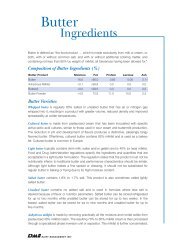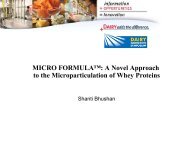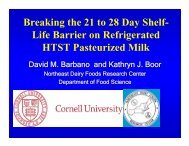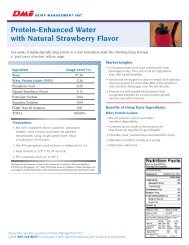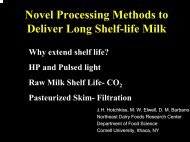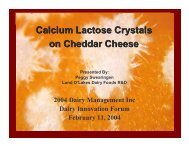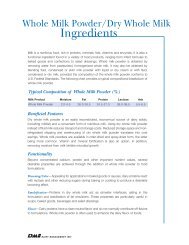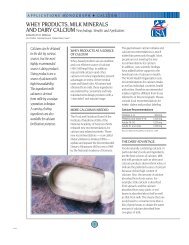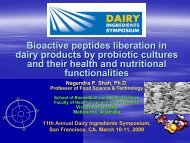Whey Protein Characteristics - InnovateWithDairy.com
Whey Protein Characteristics - InnovateWithDairy.com
Whey Protein Characteristics - InnovateWithDairy.com
Create successful ePaper yourself
Turn your PDF publications into a flip-book with our unique Google optimized e-Paper software.
more resistant to aggregation; thus, casein acts as a molecular chaperone. Alpha-casein can interact with partially<br />
unfolded proteins through hydrophobic surfaces, preventing the normal thiol-disulfide interchange with other whey<br />
proteins and eventual aggregation. This casein protein also can solubilize hydrophobically aggregated proteins. And its<br />
chaperone ability increases with decreasing temperature. 23 Other researchers also have studied the ability of alpha-casein,<br />
beta-casein and kapa-casein to be molecular chaperones. 24<br />
Beta-casein forms a <strong>com</strong>plex with proteins through electrical charges. Complex formation can occur with soluble or<br />
aggregated whey protein, and the resulting <strong>com</strong>pound is smaller than a self-aggregated whey protein <strong>com</strong>plex. Smaller<br />
<strong>com</strong>plexes were more soluble and heat tolerant to 145 C, resulting in solutions with improved clarity. The chaperone<br />
effect of milk protein concentrate was evaluated in conjunction with whey protein solutions and found to be stable at<br />
10 percent protein in a meal replacement beverage processed under retort heating conditions. 25,26<br />
Enzymatic Hydrolysis<br />
A <strong>com</strong>mon method of improving heat stability is through the enzymatic hydrolysis of whey proteins. Commercial<br />
hydrolyzed whey proteins (WPH) designed for improved heat stability generally have a 5 to 10 percent level of hydrolysis.<br />
Changes in functional properties of WPH are due to the physical characteristics of the peptides. Generally, the peptides<br />
have a lower molecular weight, exposed hydrophobic groups and more ionic groups. Typically, WPH have increased<br />
solubility, decreased viscosity and modified foaming, gelling and emulsifying properties <strong>com</strong>pared with unmodified<br />
proteins. 27 The hydrolysis process produces peptides that lack a secondary structure, resulting in minimal conformational<br />
changes during heat processing. 7 The physiochemical properties of WPH are related to the purity of the protein substrate;<br />
the pretreatment of the protein substrate; the specificity of the enzyme used for proteolysis; the physicochemical<br />
conditions (pH, temperature, ionic strength, activator) used during hydrolysis; the degree of hydrolysis; the technique used<br />
for enzyme inactivation (heat treatment, acidification or membrane filtration); and the use of post-hydrolysis treatments. 26<br />
Recent research also showed that partial hydrolysis of whey proteins improved their heat stability and functionality,<br />
but excessive hydrolysis could reduce heat stability and functionality. 28<br />
Another project utilized protein solutions containing 5 to 35g of protein per 8 oz. between pH 3.0 and 4.5. A centrifuge<br />
technique was used to remove traces of precipitated whey protein in solutions and adjusted to pH 4.6. Clarity was<br />
improved in the finished beverages using this technique, as well. This research then <strong>com</strong>bined the use of enzymes<br />
to divide the protein into water-soluble and insoluble fragments followed by centrifugation or filtration at pH 4.6. 29<br />
Researchers used trypsin to make macropeptide fragments that were too large to be bitter and too small to aggregate<br />
for the purpose of manufacturing whey proteins designed for acidic and neutral pH beverages. Beverages with improved<br />
clarity and heat stability were created even up to pH 4.6 using this method.<br />
Electrostatic Repulsion<br />
New research sponsored by the Dairy Research Institute <strong>com</strong>bined enzymatic hydrolysis with electrostatic repulsion to<br />
improve the heat stability and clarity of whey proteins. Two approaches were used to modify the charge on the whey<br />
proteins. In one approach, the positively charged portions on the protein were blocked by a succinylation reaction<br />
(modification of primary amino groups) at pH 8. This reaction reduced the number of basic groups while increasing the<br />
acidity of the protein and enhancing the electrostatic charge repulsion. In the second approach, an amidation reaction<br />
blocks the negatively charged ω-carboxyl groups and converts them to uncharged amino acids. This research determined<br />
the minimum number of charges that should be modified to increase the electrostatic repulsion and prevent aggregation<br />
at pH 3.8 to 4.6. 30<br />
23<br />
Bhattacharyya J, Das KP. Molecular chaperone-like properties of an unfolded protein, α-casein. J Biol Chem. 1999;274:15505-15509.<br />
24<br />
Morgan PE, Treweek TM, Linder RA, Price WE, Carver JA. Casein proteins as molecular chaperones. J Agric Food Chem. 2005;53:2670-2683.<br />
25<br />
Zhang X, Fu X, Zhang H, Liu C, Jiao W, Chang Z. Chaperone-line activity of β-casein. Int J Biochem Cell Biol. 2005;37:1232-1240.<br />
26<br />
Yong YH, Foegeding EA. Effects of caseins on thermal stability of bovine β-lactoglobulin. J Agric Food Chem. 2008;56:10352-10358.<br />
27<br />
Gauthier SF, Pouliot Y. Functional and Biological Properties of Peptides Obtained by Enzymatic Hydrolysis of <strong>Whey</strong> <strong>Protein</strong>s. J Dairy Sci. 2003;86(13):E78-E87.<br />
28<br />
Doucet D, Foegeding EA. Gel Formation of Peptides Produced by Extensive Enzymatic Hydrolysis of β-Lactoglobulin. Biomacromolecules. 2005;6(2):1140-1148.<br />
29<br />
Zhu D, Damodaran S, Lucey JA. Physicochemical and emulsifying properties of whey protein isolate (WPI)-Dextran conjugate produced in aqueous solution.<br />
J Agric Food Chem. 2010;58:2988-2994.<br />
30<br />
Yilmaz-Gemili A. Electrostatic repulsion enhancement for heat stable, clear whey protein beverages. M.S. thesis, 2012.<br />
e3.11.1 5



